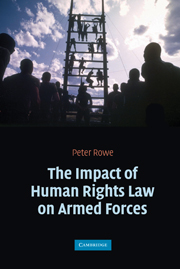Book contents
- Frontmatter
- Contents
- Preface
- 1 Human rights within the context of members of armed forces
- 2 The human rights of members of the armed forces
- 3 Human rights and the disciplinary process
- 4 Civilians before military courts
- 5 Human rights and international armed conflict
- 6 Human rights, non-international armed conflict and civil disorder
- 7 Human rights during multinational operations
- Index
6 - Human rights, non-international armed conflict and civil disorder
Published online by Cambridge University Press: 12 January 2010
- Frontmatter
- Contents
- Preface
- 1 Human rights within the context of members of armed forces
- 2 The human rights of members of the armed forces
- 3 Human rights and the disciplinary process
- 4 Civilians before military courts
- 5 Human rights and international armed conflict
- 6 Human rights, non-international armed conflict and civil disorder
- 7 Human rights during multinational operations
- Index
Summary
The use by a State of its armed forces within the boundaries of that State on what might be termed ‘combat’ activities places on the shoulders of the soldiers involved an often conflicting set of ‘laws’ as to how they should behave. Thus, military law, national law and human rights law will, and international humanitarian law may, have some bearing on their activities, although the relationship among these various sources of legal obligation will vary and their boundaries may be unclear in any particular case.
Discussion, for instance, of the legal consequences flowing from a non-international armed conflict suggests that this type of conflict can be easily distinguished from an international one or, indeed, from disorder within a State which does not amount to an armed conflict at all. In some cases this may be possible but in others there will be room for disagreement. The State concerned may deny that an armed conflict is taking place at all. Moreover, an armed conflict may be deemed to be of an international character or be international at one level and non-international at another or it may transform itself from the one to the other or into internal disorder. It may even involve non-State actors operating across national boundaries.
Where it is accepted that armed conflict is occurring within a State international humanitarian law and human rights law will, in addition to national and military law, apply to govern (in so far as law can) the actions of the armed forces of the State.
- Type
- Chapter
- Information
- The Impact of Human Rights Law on Armed Forces , pp. 163 - 223Publisher: Cambridge University PressPrint publication year: 2005

